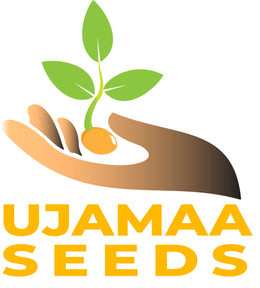
GROWING BACKYARD CORN
Growing corn in a backyard garden can be an excellent choice for several reasons:
Enjoy Corn’s Fresh Flavor: Homegrown corn tastes significantly better than store-bought, as it can be harvested at peak ripeness. The sugars in corn begin to convert to starch shortly after picking, so the fresher, the sweeter.
Fun for the Whole Family: Growing corn can be an educational and fun experience for families, especially for children who can watch the tall plants grow and harvest ears directly from the stalk. These benefits make corn an attractive addition to a backyard garden, especially if space and climate are suitable for this sun-loving crop.
Choose from Many Corn Varieties: Backyard gardeners can grow specialty varieties that aren't available in grocery stores, like heirloom or colorful varieties such as glass gem or sweet white corn.

Vertical Space Utilization: Corn grows vertically, making it a good choice for maximizing garden space. It can be interplanted with other crops in the "Three Sisters" tradition (corn, beans, and squash), where each plant supports the others. Once established, corn requires relatively little maintenance aside from consistent watering and occasional feeding, making it an easy crop for home gardeners.
Corn is Pollinator Friendly: Corn attracts pollinators like bees, which can benefit other crops in the garden. Wind-pollinated corn also helps improve air circulation in gardens. Corn stalks and leaves make good compost material after harvest, enriching the soil for future growing seasons.

The corn you grow in your backyard can be used in a variety of ways, depending on its type. Here are some ideas:
- Fresh Corn on the Cob: Enjoy it simply boiled, grilled, or roasted with butter, salt, or herbs.
- Cornmeal or Flour: Dry and grind the corn to make cornmeal or flour for homemade cornbread, tortillas, or other baked goods.
- Popcorn: If you’re growing a popcorn variety, the kernels can be dried and used for homemade popcorn.
- Canned or Frozen Corn: Preserve your harvest by canning or freezing corn kernels to enjoy throughout the year.
- Corn Salsa: Use fresh kernels in a salsa with tomatoes, onions, and cilantro.
- Corn Chowder: Create a hearty soup using your corn with ingredients like potatoes, cream, and bacon.
- Tamales: If you grow field corn, you can use the husks for tamales and make masa from the corn.
- Corn Syrup or Sweeteners: With some processing, corn can be turned into syrup for use as a sweetener.
- Livestock Feed: Dried corn is often used as feed for chickens, pigs, or other livestock.
- Decorations: If you grow ornamental varieties, like Indian corn, the colorful ears can be used for fall decorations.

TIPS ON GROWING CORN:
Growing corn in your backyard can be a rewarding experience if you follow some key tips to ensure a successful harvest:
Choose the Right Variety: Select a corn variety suited for your region's growing conditions. Sweet corn is popular for home gardens, but you can also try varieties like popcorn or ornamental corn. Make sure to check the days to maturity and choose one that fits your growing season. At Ujamaa Seeds we have several corn varieties. Select a variety that fits your location, and will be fun to watch grow.
Sun Exposure & Soil Preparation: Corn needs at least 6-8 hours of direct sunlight per day. Make sure your planting site receives full sun for best growth. Corn thrives in well-draining, fertile soil rich in organic matter. Prepare the soil by incorporating compost or well-rotted manure. Ensure the soil is loose and well-aerated to allow root growth.
Planting Corn: Wait until the soil has warmed to at least 60°F (16°C), as corn prefers warm temperatures for germination and growth. You can start planting about two weeks after the last frost date in your area. Plant corn seeds 1-2 inches deep and space them 9-12 inches apart in rows that are about 24-36 inches apart. Corn is wind-pollinated, so plant in blocks or clusters of short rows (at least four rows) rather than one long row to improve pollination. Consider succession planting too extend your harvest, plant a new batch of corn every two weeks for a continuous supply throughout the growing season.

Corn Patch Maintenance Tips: Corn requires consistent moisture, especially during the germination and tasseling stages. Water deeply once or twice a week, providing about 1 inch of water per week. Avoid wetting the foliage, as it can encourage fungal diseases. Corn is a heavy feeder, so fertilize with a nitrogen-rich fertilizer when the plants are about 6 inches tall, and again when they are about knee-high. You can use compost or a balanced organic fertilizer for this.
Keep the area around your corn free from weeds, especially during the early stages of growth. Weeds can compete with corn for nutrients and water. Mulching around the base of the plants can help suppress weeds and retain moisture.
Watch for common pests like corn earworms, cutworms, and aphids. Handpick pests or use organic pest control methods like neem oil or insecticidal soap. Practice crop rotation to avoid soil-borne diseases. Since corn relies on wind for pollination, gently shaking the plants can help disperse the pollen from the tassels to the silk on the ears. This helps ensure good kernel development.
Harvesting: Corn is ready to harvest when the ears are filled out, and the silks have turned brown. To check for ripeness, peel back a small portion of the husk and puncture a kernel; if the liquid is milky, the corn is ready.
By following these tips, you can enjoy a bountiful corn harvest from your backyard garden!


